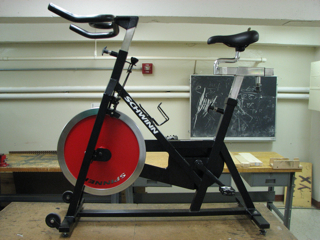Exercise bike
From DDL Wiki
Contents |
Executive Summary
Product Function
Product Use
The product is a stable platform used for cycling practice as well as a smooth, intense workout. The user mounts the bike, sitting on the seat. Feet rest on the pedals and hands on the rubber handles to the front of the bike. While holding the handles, feet on the pedals and sitting on the seat, the rider is provided a stable riding position. To ride, the user pedals forward (backward is not recommended by Schwinn) exerting significant effort to build momentum in the heavy flywheel. Once user reaches a comfortable speed their effort levels to a steady pace. There are a few ways to stop, all not very intuitive to basic bike riders. There is a knob on the frame that can be turned to apply a clamp-brake to the flywheel that will slow the wheel down. The user can also completely remove their legs from the pedal assembly, but this is not recommended since it is dangerous and the momentum in the wheel is too high and will spin for a very long time. The user could also cool down by gradually reducing their pedal speed till it becomes slow enough to dismount. This is recommended anyway in any strenuous workout, stopping abruptly is not good for the body.
Bill of Materials
| Part/Sub-assembly | Part # | Part Name | QTY | Weight (g) | Function | Manufacturing Process | Material | Image |
|---|---|---|---|---|---|---|---|---|
| Seat | 1 | Seat | 1 | 428 | Allows user to sit on bike | press fit/lay over cloth and stitch | foam, plastic, stainless steel | |
| - | 2 | bolt | 1 | 25 | Assembles seat to seat support | forging, thread rolling | stainless steel | |
| - | 3 | sm. washers | 2 | 15 | Assembles seat to seat support | stamping | stainless steel | |
| - | 4 | lg. washers | 2 | 15 | Assembles seat to seat support | forging, thread rolling | stainless steel | |
| - | 5 | nuts | 2 | 5 | Assembles seat to seat support | casting thread tapping | stainless steel |
All extra weight on frame =
10271
- We were not able to dissect the wheel sub-assembly due to the high pressure that the assembly is under at all times. Dissecting the wheel would be extremly dangerous, and once it was dissected, getting the wheel under the same high pressure would have requried special tools that we do not have access to. The conclusion that dissection was not a good idea was supported by the expert machinists in the Carnegie Mellon machine shop in Hamerschlag Hall.
- Removing the bike pedals from the bike frame was not a possibility for our group due to the need of a special bike-specific tool called a crank arm extractor. More information can be found by watching this video: http://www.youtube.com/watch?v=H6aHvq4oD9o. In addition, the sprocket is welded to the pedal crank, making it impossible to remove.
Design for Manufacture and Assembly (DFMA)
Design for Manufacture
Abe
Design for Assembly
Casey
FMEA
Boss
Design for Environment (DFE)
Abe and Casey
Mechanical Analysis
Shobhit

